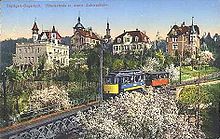Vineyards
|
Weinsteige district of Stuttgart |
|
|---|---|
| Coordinates | 48 ° 45 '33 " N , 9 ° 10' 21" E |
| surface | 0.615 km² |
| Residents | 2169 (May 31, 2020) |
| Population density | 3527 inhabitants / km² |
| Post Code | 70180 |
| prefix | 0711 |
| Borough | Stuttgart-South |
| Source: Data Compass Stuttgart (PDF; 1.9 MB) | |
Weinsteige is the name given to a Stuttgart district with the main connecting roads Alte and Neue Weinsteige , which lead from the city center in the basin to the southern Filder places ( Degerloch , Möhringen , etc.) 200 meters higher . Large parts of the city center can be seen from both streets.
Old vineyards
The Alte Weinsteige, an extremely steep cart path that all freight wagon traffic had to take to the south, was first mentioned in 1350. Up to 16 horses were required as a leader to tackle the climb .
In the Duchy of Württemberg , it formed the border between the Oberland ( ... above the Steig ) and the Unterland ( ... under the Steig ) in some administrative matters . In the Württemberg part of Baden-Württemberg , however, the terms are used differently today: Oberland is the area between the Danube and Lake Constance , Unterland is the area around Heilbronn .
The cog railway has been running along the Alte Weinsteige since 1884 .
At the Alte Weinsteige there is an important dial-up point , a large computer for connecting to the Internet.
New vineyards
Since the incline of the Alte Weinsteige could only be overcome with the help of large horse-drawn carts, there were considerations to build a flatter transport link since the beginning of the 19th century. In 1822, the Royal Senior Building Officer Eberhard von Etzel received the order from King Wilhelm I of Württemberg to build a more efficient connection between Stuttgart and the communities in the south.
Between 1826 and 1831 the Neue Weinsteige, a wide panoramic road, was built according to Etzel's plans. It was opened on October 23, 1831. It was initially called Wilhelmstrasse and only got its current name in 1846. Up to our time it is considered to be a pioneering engineering achievement. It cost 76,000 guilders to build (around six million euros today). Due to the high construction costs, the city collected customs and paving money for the passage of the route until 1922 . Etzelstraße, which branches off from Neue Weinsteige, is named after its builder.
The upper part of Neue Weinsteige is part of Bundesstrasse 27 as the main exit and access road , while in the lower part, where Hohenheimer Strasse has taken over this function, it has become a residential street. The extension of the Neue Weinsteige to the Degerloch markings has been called Obere Weinsteige since 1912 .
Rail transport
The Neue Weinsteige line operated by the Filderbahn-Gesellschaft (FBG) as a tram connection between Stuttgart and Degerloch ran along the Neue Weinsteige from 1904 . In 1920 this was connected to the Stuttgart tram network and was completely integrated into it from 1933/34. Due to its panoramic view, it was considered one of the most beautiful tram routes in Germany, but was relocated to a parallel tunnel in the course of the urban railway expansion in 1987/1990. With the exception of the crossing of the Stuttgart rack railway, there is no longer any rail traffic on the Neue Weinsteige.
Large vineyard location "Weinsteige" in viticulture
The Weinsteige is also the namesake for the large site , which includes all of Stuttgart's vineyards (→ Viticulture in Stuttgart ). A total of 616 hectares of cultivation area in Stuttgart, Esslingen , Fellbach and Gerlingen belong to the Weinsteige site . Today, however, hardly any wines are offered under the designation Weinsteige , because the producers in the area either fill their bottles by specifying individual vineyards or dispense with site names entirely. Only the winery of the city of Stuttgart uses the name Stuttgarter Weinsteige for those wines that actually grow directly on the Neue Weinsteige. One hectare by dry walls secured steep slope is Trollinger generated. The wine law is thus turned upside down in terms of naming , because the associated single location is the Stuttgart Mönchhalde .



